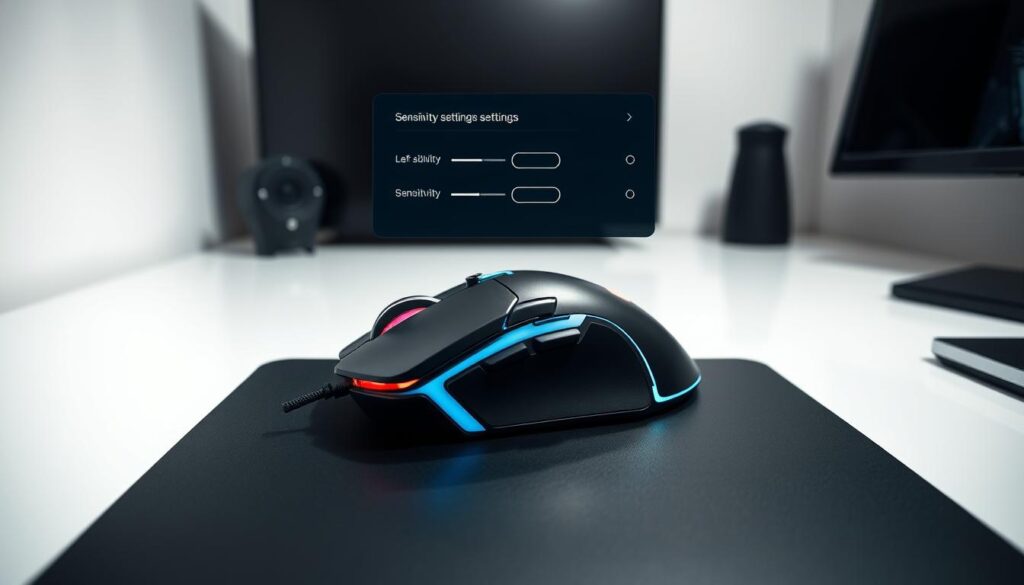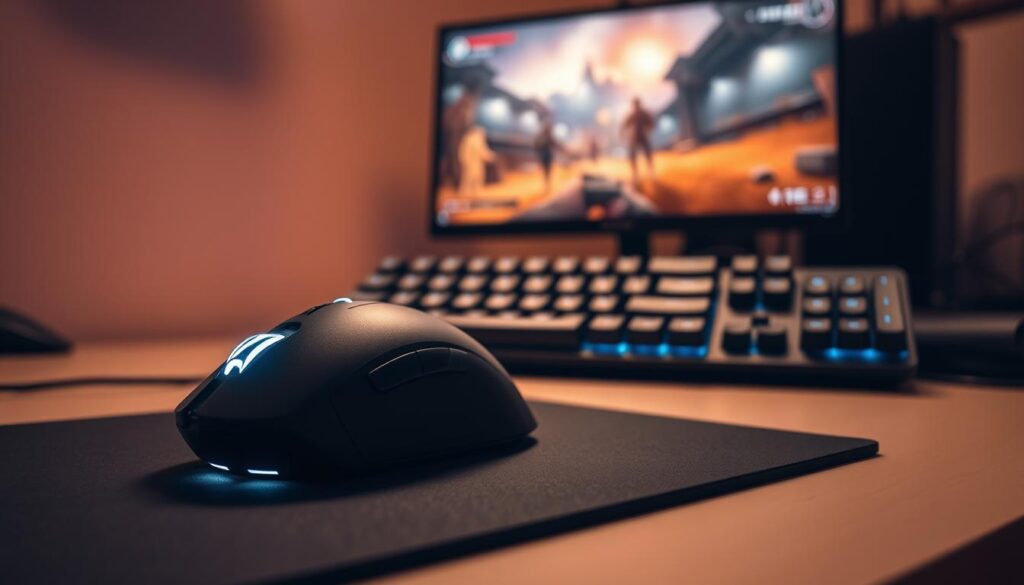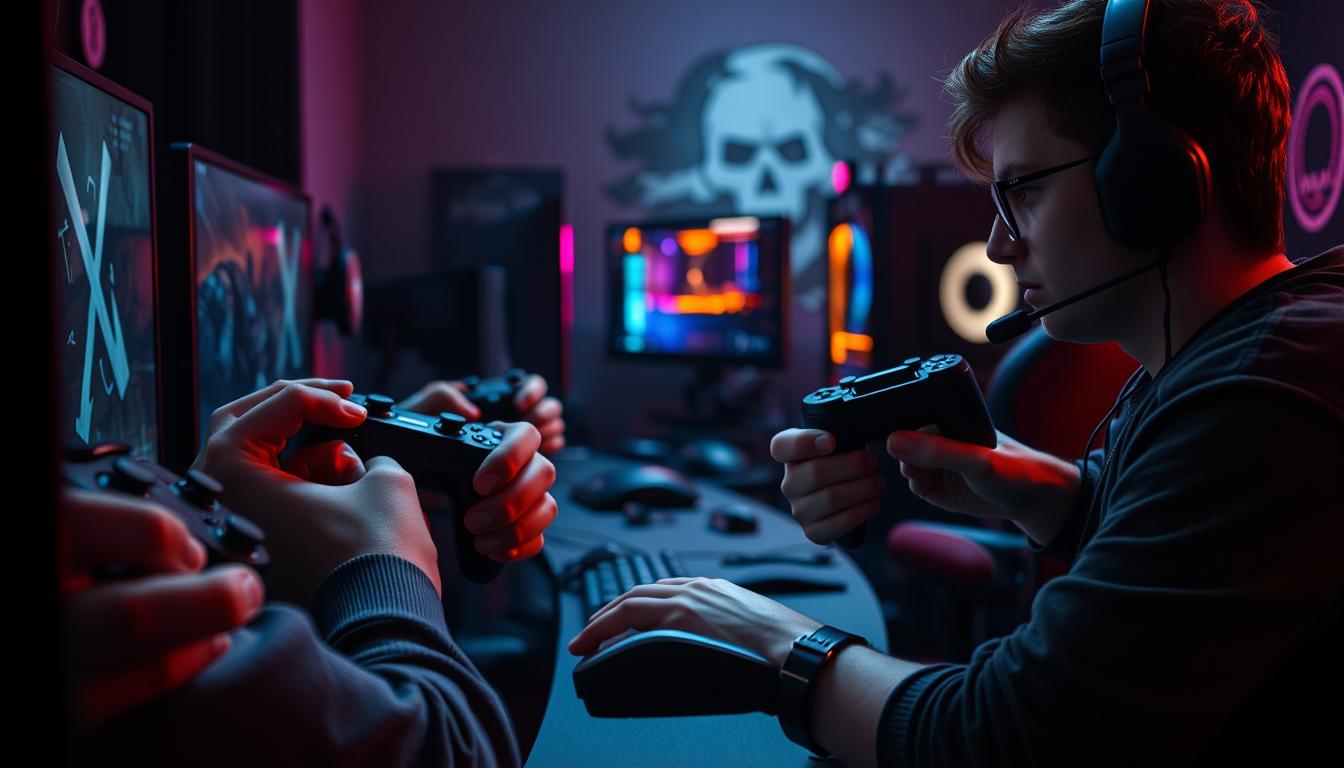Anúncios
Ever wondered why some left-handed players excel in FPS games, while others struggle? It often comes down to mouse sensitivity control. This guide will cover key topics like DPI, eDPI, and raw input, all for left-handed gamers. By tweaking your mouse settings, you can improve your aim and gaming experience.
Understanding Mouse Sensitivity
Mouse sensitivity is key in gaming, especially in FPS games. It shows how much the mouse moves and how far the cursor goes on the screen. Players tweak their sensitivity to get the best gaming experience.
Anúncios
High sensitivity means quick movements, which is great for fast actions. But, low sensitivity helps with aiming, making shots more precise. Knowing how these settings impact your game is vital for FPS fans wanting to get better.
Adjusting mouse sensitivity depends on personal taste and game needs. Some like high sensitivity for quick turns, while others prefer low for better aiming at long ranges. Trying out different settings can help find the perfect balance for better gaming.
DPI Explained: The Foundation of Mouse Sensitivity
DPI, or Dots Per Inch, is key in mouse sensitivity. It shows how many pixels the cursor moves for each inch of mouse movement. Knowing DPI can boost your gaming skills, especially in fast games like first-person shooters.
Anúncios
What Does DPI Mean?
DPI measures mouse sensitivity. A higher DPI means the cursor moves faster on the screen. A lower DPI gives finer control. Most gamers prefer DPI between 800 and 1600 for most games.
For precise aiming, a lower DPI is better. This range lets gamers choose between fast movements and careful aiming.
How DPI Impacts Gaming Performance
DPI greatly affects your gaming. High DPI is good for quick games, letting you react fast. For precise aiming, lower DPI is better.
Competitive gamers often choose DPI between 400 to 1600. This balance helps them adapt to different game situations.
Understanding eDPI for FPS Gaming
In FPS gaming, knowing how to set your mouse sensitivity is key. eDPI, or effective DPI, is a crucial concept. It helps players balance their mouse DPI and in-game sensitivity for better aim.
What is eDPI?
eDPI stands for effective DPI. It shows how sensitive your mouse feels in games. It’s the DPI setting times the in-game sensitivity. Knowing your eDPI helps you adjust for better aim and response in FPS games.
How to Calculate Your eDPI
To find your eDPI, multiply your DPI by your in-game sensitivity. For instance, if DPI is 800 and sensitivity is 1.5, your eDPI is 1200. This shows how far your crosshair moves per mouse movement. Learning to calculate eDPI helps players control and aim better in fast games.
Importance of Raw Input for Gaming Accuracy
Understanding raw input is key for top gaming accuracy, especially in competitive games. It lets mouse movements directly control in-game actions, without OS tweaks. This ensures players have precise control, boosting their game performance.
What is Raw Input?
Raw input means mouse signals go straight to the game. Unlike usual settings, where OS might change mouse sensitivity, raw input keeps it consistent. This direct link is vital for gamers needing quick and precise aiming.
Turning Off Mouse Acceleration
Mouse acceleration can mess up the natural mouse movement to cursor speed link. It changes sensitivity based on speed, causing unpredictable aiming. Turning it off is a must for FPS players aiming for top performance.
To disable mouse acceleration in Windows, go to the mouse options in the Control Panel. Make sure “enhanced pointer precision” is not checked.
By doing this, players keep their aim consistent and improve their gaming accuracy. Those serious about gaming will see a big difference in their performance with raw input and no mouse acceleration.
Configuring Your Gaming Mouse
Setting up your gaming mouse is key to a better gaming experience. It lets you tweak settings for different games. Most gaming mice have special software for customizing.
Downloading and Installing Mouse Software
First, download and install the right mouse software. Brands like Razer, Logitech, and Corsair have apps for adjusting settings and more. This software unlocks cool features and helps tweak the polling rate for better performance.
Adjusting Polling Rate for Optimal Performance
The polling rate affects how fast your mouse talks to your computer. It’s measured in Hertz (Hz). Rates range from 125Hz to 1000Hz. For less lag and better response, choose the highest rate your mouse and computer support.
Adjusting your mouse settings, like polling rate, boosts performance. It’s great for competitive play or a smoother game. For more tips, see this guide on improving tracking without changing sensitivity.
Finding the Right Sensitivity for You
Finding the right sensitivity settings is key to a better gaming experience. Everyone has their own preferences, so it’s important to try both high DPI and low DPI. Each has its own benefits for different playing styles.
High DPI vs Low DPI: Which is Better?
High DPI settings make your mouse move fast, which is great for quick games. It helps you change direction quickly, which is important for fast-paced games. But, low DPI settings are better for accuracy, especially in strategic games where you need to aim well.
So, whether you choose high DPI or low DPI depends on the games you like and how you play them.
The Role of Personal Preference in Sensitivity Settings
Your personal taste really matters when picking sensitivity settings. Everyone likes different things, and what feels right for you might not for someone else. Trying out different sensitivity levels can help you find what works best for you.
Keep checking how you feel and play over time. This will help you fine-tune your settings to match your gaming style perfectly.

Guide to Sensitivity Control for Left-Handed FPS Players
Finding the right gaming mouse is key for left-handed FPS players. A left-handed gaming mouse boosts comfort and accuracy. The Razer Viper Ultralight is made for left-handed players, offering top-notch performance.
This ensures players have precision and control in FPS games.
Choosing the Right Mouse for Left-Handed Players
A left-handed gaming mouse is crucial for comfort. Look for customizable buttons, ergonomic design, and light weight. The Zowie FK series offers ambidextrous options, perfect for left-handed gamers.
Remapping Keys for Improved Comfort
Remapping keys can greatly improve comfort and gameplay. Players can switch controls from WSAD to IKJL, easing finger strain. This customization lets left-handed gamers set up controls naturally, enhancing their FPS experience.
Understanding Ergonomics in Gaming
Good ergonomics is key to enjoying gaming more. How you hold your hands and arms affects your game play. It’s important to keep your posture right to avoid getting tired and to play better.
Left-handed players need to think about how their setup affects them. This can make a big difference in their gaming experience.
The Posture of Your Hand and Arm Matters
Your hand and arm position greatly affects your mouse use. Bad posture can make you uncomfortable and hurt your game play. It’s important to keep your wrist straight and your elbows at a good angle.
This helps you avoid strain and improves your control. Paying attention to how your hand is placed makes gaming more fun.
Finding an Ideal Mouse Pad Size
The size of your mouse pad is very important. A bigger pad lets you move your mouse more freely. This is good for players who like fast movements.
With enough space, you can move smoothly without lifting the mouse. The right size pad supports good posture and makes gaming more comfortable. This lets you focus on your game without distractions.
How Playstyle Influences Sensitivity Settings
Finding the right sensitivity settings can really boost your gaming fun. Your playstyle often decides if you need high or low sensitivity. Knowing this helps players do their best in different game situations.
High Sensitivity for Fast-Paced Games
Games like Call of Duty and Titanfall need quick moves and fast reactions. High sensitivity lets players turn fast and hit targets quickly. It’s perfect for those who love fast action and don’t mind a bit of roughness.
Low Sensitivity for Precision-Based Games
Games like CSGO and Valorant need careful aiming. Low sensitivity helps players aim better, making shots more accurate. Players who like to take their time and aim well prefer low sensitivity. It’s all about finding what works best for you.

Trial and Error: Fine-Tuning Your Sensitivity Settings
Finding the right mouse sensitivity is a journey of trial and error. Players need to spend time testing different values. This helps them understand what feels best and how it affects their aim in games.
Ways to Test Your Sensitivity Options
There are several ways to test your sensitivity settings. Here are some effective methods:
- Practice aiming at targets to check your precision.
- Play live matches to see how changes work under pressure.
- Use aim training tools online or through gaming platforms.
Adjusting Settings Over Time
It’s important to keep an eye on your performance over time. This helps you make better choices about your settings. Keeping track of changes and their effects can give you valuable insights. Here are key things to watch:
- See if your headshot rates and accuracy improve.
- Check how comfortable you feel during long gaming sessions.
- Notice if you’re consistent in achieving your goals in different game modes.
Common Mistakes to Avoid
Many gamers unknowingly harm their gaming by making common mistakes. These errors can greatly improve your gaming experience. Two big mistakes are ignoring DPI calibration and sticking with default settings.
Neglecting DPI Calibration
Not calibrating DPI can cause your mouse to move inaccurately. This can mess up your gameplay. By calibrating DPI, your mouse will move as you intend, boosting your performance.
Customizing DPI settings can greatly improve your game in competitive play.
Sticking with Default Settings
Using default settings can also hold you back. These settings don’t fit everyone’s play style. They can lead to poor gaming performance.
Adjusting settings to fit your needs can greatly enhance your gaming. It leads to better precision and fun.
Conclusion
Mastering mouse sensitivity control is key for left-handed FPS players. It helps improve their gaming experience. Knowing about DPI and eDPI lets gamers choose settings that fit their style.
This knowledge boosts their performance, giving them an edge in competition. It’s all about making the right choices for better gaming.
Also, focusing on raw input and ergonomics is vital. It makes sure left-handed players are both comfortable and efficient. By adjusting sensitivity to their liking, they can play more precisely and enjoy the game more.
In short, the path to perfect mouse sensitivity involves learning, practicing, and tweaking. This guide has given left-handed FPS players the tools to enhance their gaming. They can now make adjustments that will greatly improve their performance.





